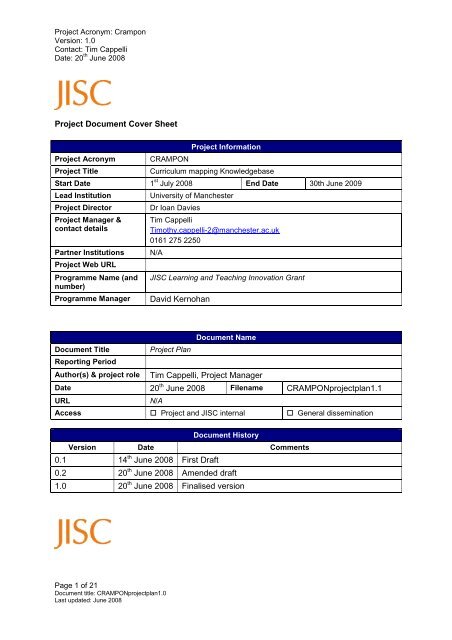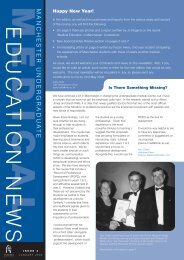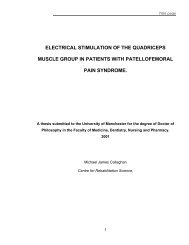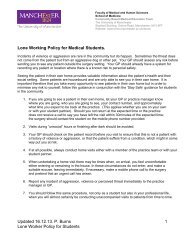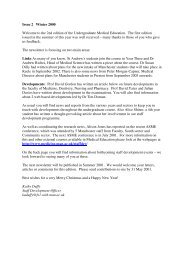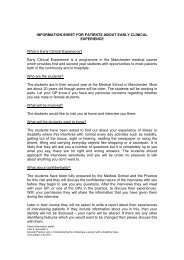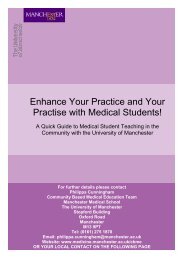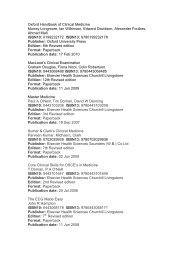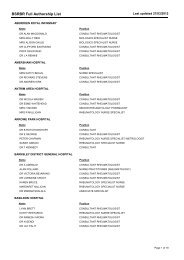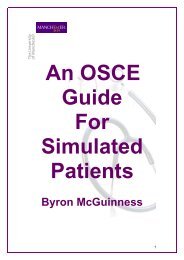Project Document Cover Sheet David Kernohan Tim Cappelli ...
Project Document Cover Sheet David Kernohan Tim Cappelli ...
Project Document Cover Sheet David Kernohan Tim Cappelli ...
You also want an ePaper? Increase the reach of your titles
YUMPU automatically turns print PDFs into web optimized ePapers that Google loves.
<strong>Project</strong> Acronym: Crampon<br />
Version: 1.0<br />
Contact: <strong>Tim</strong> <strong>Cappelli</strong><br />
Date: 20 th June 2008<br />
<strong>Project</strong> <strong>Document</strong> <strong>Cover</strong> <strong>Sheet</strong><br />
<strong>Project</strong> Acronym CRAMPON<br />
Page 1 of 21<br />
<strong>Document</strong> title: CRAMPONprojectplan1.0<br />
Last updated: June 2008<br />
<strong>Project</strong> Information<br />
<strong>Project</strong> Title Curriculum mapping Knowledgebase<br />
Start Date 1 st July 2008 End Date 30th June 2009<br />
Lead Institution University of Manchester<br />
<strong>Project</strong> Director Dr Ioan Davies<br />
<strong>Project</strong> Manager &<br />
contact details<br />
Partner Institutions N/A<br />
<strong>Project</strong> Web URL<br />
Programme Name (and<br />
number)<br />
Programme Manager <strong>David</strong> <strong>Kernohan</strong><br />
<strong>Document</strong> Title <strong>Project</strong> Plan<br />
Reporting Period<br />
<strong>Tim</strong> <strong>Cappelli</strong><br />
<strong>Tim</strong>othy.cappelli-2@manchester.ac.uk<br />
0161 275 2250<br />
JISC Learning and Teaching Innovation Grant<br />
<strong>Document</strong> Name<br />
Author(s) & project role <strong>Tim</strong> <strong>Cappelli</strong>, <strong>Project</strong> Manager<br />
Date 20 th June 2008 Filename CRAMPONprojectplan1.1<br />
URL N/A<br />
Access <strong>Project</strong> and JISC internal General dissemination<br />
<strong>Document</strong> History<br />
Version Date Comments<br />
0.1 14 th June 2008 First Draft<br />
0.2 20 th June 2008 Amended draft<br />
1.0 20 th June 2008 Finalised version
<strong>Project</strong> Acronym: CRAMPON Contact: <strong>Tim</strong> <strong>Cappelli</strong><br />
Version: 1.1 Date: 20 th June 2008<br />
JISC <strong>Project</strong> Plan<br />
CRAMPON: A curriculum mapping knowledgebase<br />
Overview of <strong>Project</strong><br />
1. Background<br />
This project sets out to create a knowledgebase application (software) to manage and maintain the<br />
complex interrelationships between curriculum content, cases for enquiry based learning and their<br />
intended learning outcomes (ILOs), and assessment blueprinting based on the ILOs.<br />
The application will be generic for any structured curriculum but will be tested on the Manchester<br />
MBChB curriculum, using Indexed Clinical Situations, module intended learning outcomes, Formative<br />
and Summative Assessment and PBL cases.<br />
The principal users of the system will be academic curriculum development teams, students who will<br />
use appropriate search facilities to plan their learning and administrators who will use the tool to assist<br />
in resource planning and change management.<br />
This project addresses the complexity of the interrelationships between the component parts of<br />
undergraduate enquiry based learning in medicine and other structured curricula such as Dentistry<br />
and Engineering. There are known difficulties in the transition from traditional instruction to a PBL<br />
approach 12 and curriculum design must address issues of preparing a syllabus, finding appropriate<br />
problems/ cases to address content, introducing students to group process and learning skills, etc. In<br />
addition, the curricula of degrees related to professional qualifications like Medicine have to undergo a<br />
continual process of review; either for purposes of development, modernization or review by a<br />
professional body, e.g. by the General Medical Council (GMC) 3 . Reviews are complex and have to be<br />
completed in relatively short time-frames. There are currently no tools available that support the<br />
design, development and maintenance of such curricula in a coherent manner, nor in any kind of<br />
teamwork environment.<br />
The development for this project will comprise an underpinning formal model, an operational<br />
knowledgebase for all the necessary elements and their connections to each other and an intuitive<br />
interface suited to the patterns of use of both academics and students. The user interface will be<br />
embedded in a social software framework allowing teams of academics to work together on<br />
curriculum design. It is envisaged that the user interface will also enable students, either as<br />
individuals or groups to plan their learning. If the self-directed learning is supported by an e-portfolio,<br />
the students will be able to link between the curriculum knowledgebase and their own portfolios.<br />
The project test case is the curriculum for undergraduate medical students at the Manchester Medical<br />
School (MMS) which is centred on a Problem Based Learning (PBL) approach to learning (PBL being<br />
a special case of enquiry based learning). The curriculum consists of a number of themed modules<br />
each having its own Intended Learning Outcomes and set of clinical skills. The students gain their<br />
required knowledge and skills through study and analysis of a set of themed cases derived from a<br />
core curriculum of Indexed Clinical Situations (ICS). Student learning is augmented by lectures,<br />
seminars and clinical placements and skills training. Each student is assessed throughout the five<br />
year programme, using a range of assessment techniques, to ensure they have acquired the relevant<br />
skills and knowledge and have achieved the standard required by the GMC to be fit to practice.<br />
1 White III, HB, Getting started in problem-based learning, in The power of problem-based learning: A<br />
practical "How to" for teaching undergraduate course in any discipline, Duch, BJ, Groh, SE, and Allen,<br />
DE, Editors. 2001, Stylus Publishing, LLC: Sterling<br />
2 Sefton, A, Overcoming obstacles, in Problem-Based Learning: Case studies, Experience and<br />
Practice, Schwartz, PL, Mennin, S, and Webb, G, Editors. 2001, Kogan Page Ltd.: London. p. 52-59,<br />
3 (GMC: http://www.gmc-uk.org/education/undergraduate/undergraduate_qa.asp ).<br />
Page 2 of 21<br />
<strong>Document</strong> title: JISC <strong>Project</strong> Plan CRAMPONprojectplantV1.1.doc<br />
Last updated: 20/08/2008 16:11
<strong>Project</strong> Acronym: CRAMPON Contact: <strong>Tim</strong> <strong>Cappelli</strong><br />
Version: 1.1 Date: 20 th June 2008<br />
The curriculum based on the ICSs, themed modules and ILOs, assessments and standards form a<br />
complex, multi-dimensional matrix of information elements which are linked through many-to-many<br />
relationships at multiple levels of granularity. This complexity presents problems on two fronts: for<br />
academics in preparation for quality reviews, and planning and executing changes to the curriculum;<br />
and for students making appropriate aspects of the curriculum intuitively visible to facilitate selfdirection<br />
of his/her own learning. For example, updating any aspect of the curriculum in line with new<br />
guidelines from the QAA 4 or GMC involves identifying and tracking the related parts on which that<br />
aspect may impinge and agreeing the changes within the curriculum development team. The medical<br />
curriculum must remain dynamic and respond to changes in medical practice and legislation but its<br />
maintenance is becoming increasingly difficult and expensive.<br />
In setting out to provide some solutions to the above issues, the project builds on previous work in<br />
modelling and specifying services for medical education at Manchester (Horus and HeLM), on<br />
designing a knowledgebase to support good practice (Pathfinder), on domain modelling and<br />
knowledge engineering in HE (HILDA and InnovationBase(IB)) and on embedding tools within social<br />
networking software (HeLMET).<br />
2. Aims and Objectives<br />
Aim: To create tool support for systematic design, review and maintenance of curricula. The tool is to<br />
facilitate maintenance of curriculum quality and currency and is to be designed for usability, extension<br />
and generalisability.<br />
Objectives:<br />
• A knowledgebase for curriculum content with its relationships to assessment and enquiry<br />
based learning;<br />
• Lifecycle maintenance of curriculum content;<br />
• Manipulation of knowledge elements to assess impact of change;<br />
• Facilitation of consultation with all stakeholders;<br />
• Facilitation of reporting and demonstration of quality and compliance to QA and standards<br />
bodies;<br />
• A tool to plan training requirements for staff development.<br />
3. Overall Approach<br />
The <strong>Project</strong> will use the UIDM approach to achieve its objectives, using the tools and methods<br />
advocated in the UIDM templates and guidelines.<br />
During Stages 1 & 2 of the UIDM, Interviews and workshops will be carried out with the three main<br />
domain experts representing Curriculum Development and Assessment. From this, an initial set of<br />
user requirements and user cases will be constructed together with an initial Domain Model on which<br />
to base the construction of the Crampon knowledgebase. This initial model will be tested and refined<br />
through additional workshops with wider domain experts such as learners and tutors together with<br />
validation by external partners Keele University and Peninsula Medical School (PMS). From this a<br />
more complete Curriculum Domain Model will emerge.<br />
The project will then move on to UIDM Stages 3 & 4, through the development and evaluation of<br />
successive iterations of the knowledgebase. The initial knowledgebase will be constructed using the<br />
applications outlined in section 9, concentrating initially on the back-end repository, followed by an<br />
intuitive, browser based front-end. The initial repository will be tested with Domain experts in the<br />
University of Manchester, followed by necessary refinement and development and testing of the frontend.<br />
Once a relatively stable version of the knowledgebase is constructed and populated using<br />
4<br />
Quality Assurance Agency for Higher Education http://www.qaa.ac.uk/aboutus/default.asp<br />
Page 3 of 21<br />
<strong>Document</strong> title: JISC <strong>Project</strong> Plan CRAMPONprojectplantV1.1.doc<br />
Last updated: 20/08/2008 16:11
<strong>Project</strong> Acronym: CRAMPON Contact: <strong>Tim</strong> <strong>Cappelli</strong><br />
Version: 1.1 Date: 20 th June 2008<br />
current curriculum elements the tool will be evaluated using three test cases within the University.<br />
These will represent three examples of realistic tool use across different groups of potential users:<br />
1. The introduction of a new Indexed Clinical Situation (ICS). The tool will be used by the<br />
curriculum development team to introduce a new ICS, for example on AIDS, to assess how<br />
well the tool identifies impact on and duplication of existing curriculum elements.<br />
2. The introduction of a new learner topic. An existing student group, HOMED, will use the tool<br />
to introduce the topic of homelessness into the curriculum using the tool. They will assess the<br />
success of the knowledgebase in identifying where the topic can be introduced into the<br />
curriculum, which ICS’s it impinges on and which Intending Learning Outcomes it supports.<br />
3. The resource implications of change. Any external changes or changes to the curriculum<br />
impacts on how and where the programme is delivered. The tool will therefore be tested by<br />
administrators to calculate resources and management issues around a given change e.g. the<br />
concentration of specialism within NHS Trusts may restrict the throughput of students within a<br />
given module and the tool should be able to help plan learning delivery to resolve such<br />
issues.<br />
Following the successful testing of the initial software releases, the tool will be then be validated and<br />
evaluated for its generalisability through a series of planned workshops in Keele and PMS. The two<br />
external institutions will be consulted on the design of test cases which would be representative of<br />
their own institutional requirements in order to bring a genuine outside perspective to the tool, this<br />
would enable them to judge its usefulness and application. This will allow the project to devise a set<br />
of rules for generalisation of the knowledgebase and make any necessary refinements to the tool.<br />
Critical Success Factors<br />
• Accurate capture of the complex curriculum domain which can be represented by knowledgebase<br />
modelling.<br />
• Integration and interoperability of the two major components of the proposed application:<br />
knowledgebase and social networking<br />
• Scalability and usability of the completed application<br />
• Accuracy and relevance of the knowledgebase in completing given test cases<br />
4. <strong>Project</strong> Outputs<br />
Month WP1<br />
<strong>Project</strong><br />
Management<br />
1.<br />
(July<br />
2008)<br />
2.<br />
(August<br />
2008)<br />
3.<br />
(Sept<br />
2008)<br />
4.<br />
(Oct.<br />
2008)<br />
<strong>Project</strong> web<br />
page<br />
<strong>Project</strong><br />
website<br />
Progress<br />
Report - Brief<br />
WP2<br />
Systems<br />
Analysis<br />
Initial Interviews<br />
with major<br />
Stakeholders<br />
Initial Domain<br />
Model for<br />
Curriculum<br />
Stakeholder<br />
workshops<br />
Contact<br />
Sessions with<br />
Peninsula<br />
Medical School<br />
and Keele<br />
University<br />
Domain Model<br />
For Curriculum<br />
Use Cases for<br />
Page 4 of 21<br />
<strong>Document</strong> title: JISC <strong>Project</strong> Plan CRAMPONprojectplantV1.1.doc<br />
Last updated: 20/08/2008 16:11<br />
WP3<br />
Knowledgebase<br />
Development<br />
WP4<br />
Implementation<br />
& User<br />
Evaluations<br />
WP5<br />
<strong>Project</strong><br />
Evaluation &<br />
Dissemination
<strong>Project</strong> Acronym: CRAMPON Contact: <strong>Tim</strong> <strong>Cappelli</strong><br />
Version: 1.1 Date: 20 th June 2008<br />
Month WP1<br />
<strong>Project</strong><br />
Management<br />
5.<br />
(Nov.<br />
2008)<br />
6.<br />
(Dec.<br />
2008)<br />
7.<br />
(Jan.<br />
2009)<br />
9.<br />
(March<br />
2009)<br />
10.<br />
(April<br />
2009)<br />
11.<br />
(May<br />
2009)<br />
12.<br />
(Jun.<br />
2009)<br />
Progress<br />
Report - Full<br />
Budget report<br />
Progress<br />
Report - Brief<br />
Final report<br />
(draft)<br />
Final report<br />
(Final)<br />
Completion<br />
report<br />
WP2<br />
Systems<br />
Analysis<br />
Curriculum<br />
Management<br />
Domain aligned<br />
with Innovation<br />
Base, P-SPEX<br />
and HILDA<br />
Service Usage<br />
Models for<br />
Curriculum<br />
Management<br />
Page 5 of 21<br />
<strong>Document</strong> title: JISC <strong>Project</strong> Plan CRAMPONprojectplantV1.1.doc<br />
Last updated: 20/08/2008 16:11<br />
WP3<br />
Knowledgebase<br />
Development<br />
Knowledgebase<br />
Application<br />
(Backend<br />
repository) v0.1<br />
Knowledgebase<br />
Application v0.2<br />
Knowledgebase<br />
Application v0.3<br />
Knowledgebase<br />
Application –<br />
Final Release<br />
WP4<br />
Implementation<br />
& User<br />
Evaluations<br />
User Evaluation<br />
Report v0.1<br />
User Evaluation<br />
Report v0.2<br />
User Test<br />
Cases –<br />
University of<br />
Manchester<br />
Application<br />
Validation and<br />
evaluation at<br />
Peninsula<br />
Medical School<br />
and Keele<br />
University<br />
User<br />
<strong>Document</strong>ation<br />
Generalisation<br />
Specification<br />
WP5<br />
<strong>Project</strong><br />
Evaluation &<br />
Dissemination<br />
Evaluation<br />
Report from<br />
Validation Trials<br />
<strong>Project</strong><br />
Effectiveness<br />
Report<br />
Recommendation<br />
report/ Lessons<br />
Learnt<br />
National<br />
Workshop<br />
“Curriculum<br />
Design and<br />
Maintenance with<br />
a Curriculum<br />
Knowledgebase”<br />
In addition, knowledge and experience from the project on such topics as using the UIDM approach to<br />
constructing complex knowledgebases, will be shared through JISC events and Conferences.
<strong>Project</strong> Acronym: CRAMPON Contact: <strong>Tim</strong> <strong>Cappelli</strong><br />
Version: 1.1 Date: 20 th June 2008<br />
5. <strong>Project</strong> Outcomes<br />
The curriculum knowledgebase will be able to:<br />
1. Support definition of a core curriculum that may be used to separate foundation material from<br />
later, more complex concepts;<br />
2. Support mapping of external criteria onto the curriculum to ensure the programme is meeting<br />
performance quality criteria;<br />
3. Link assessments to the curriculum as a form of blueprinting to ensure that the curriculum is<br />
examined appropriately and systematically;<br />
4. Ensure that the curriculum is actually being delivered through the PBL cases in the themed<br />
semesters;<br />
5. Allow curriculum content design and revision to be more systematic, rigorous and transparent,<br />
while simultaneously extending ‘ownership’ of the curriculum to a larger group of teachers who<br />
would otherwise never be consulted;<br />
6. Manage the process of change in any of the curriculum components and its impact on the<br />
curriculum overall;<br />
7. Allow focus on management of the curriculum in any professional qualification (for example,<br />
engineering, medicine, dentistry);<br />
8. Allow students’ planning of their learning to be better structured. For example, allowing<br />
identification of strands of activity in the programme for scaffolding learning;<br />
9. Connection to an e-portfolio will provide learners with the ability to maintain learning logs in a far<br />
more systematic manner, enabling the construction of more focused action plans to remedy<br />
weaknesses in learning and skills;<br />
10. Allow browsing of the curriculum according to routes tailored to a set of student, tutor and<br />
administrator required viewpoints;<br />
11. Support research leading to greater student input into the curriculum;<br />
12. Support research leading to improved assessment processes;<br />
13. Allow search for particular elements of the curriculum by both students and curriculum designers.<br />
The ability to search the knowledgebase will to some extent alleviate the well known problems of<br />
uncertainty and anxiety among students in PBL programmes;<br />
14. The embedding in social software supports widespread collaboration and consultation on<br />
curriculum expertise outside the institution.<br />
6. Stakeholder Analysis<br />
Stakeholder Interest / stake Importance<br />
<strong>Project</strong> Team Delivery of successful project/ Provide the<br />
main activities<br />
HIGH<br />
Users – Curriculum Development Affordances from the project: The ability to HIGH<br />
Team<br />
ensure the curriculum is complete and<br />
holistic in providing the required skills and<br />
knowledge, maintenance of a complex<br />
electronic curriculum repository and the<br />
ability to control/regulate curriculum change<br />
Users - Learners Affordances from the project: The ability to<br />
plan and manage self-directed learning in a<br />
complex environment, a scaffold for learning<br />
and inclusion in curriculum change and<br />
management<br />
HIGH<br />
Users – Tutors Affordances from the project: The ability to<br />
track and manage the learning and<br />
assessment of students through a complex<br />
curriculum, the ability to focus support and<br />
content of learning in relevant areas, thereby<br />
reducing duplication and identifying<br />
deficiencies and support for a facilitation role<br />
HIGH<br />
Page 6 of 21<br />
<strong>Document</strong> title: JISC <strong>Project</strong> Plan CRAMPONprojectplantV1.1.doc<br />
Last updated: 20/08/2008 16:11
<strong>Project</strong> Acronym: CRAMPON Contact: <strong>Tim</strong> <strong>Cappelli</strong><br />
Version: 1.1 Date: 20 th June 2008<br />
University Senior Management<br />
(President/ Vice Chancellor)<br />
Page 7 of 21<br />
<strong>Document</strong> title: JISC <strong>Project</strong> Plan CRAMPONprojectplantV1.1.doc<br />
Last updated: 20/08/2008 16:11<br />
Part of the e-learning strategy of the<br />
University, exploitation of the tool by other<br />
professional schools using PBL approach –<br />
e.g. engineering<br />
HIGH<br />
Manchester Medical School Investment of resource/ Improvement of their<br />
teaching provision<br />
HIGH<br />
Funding body – JISC Grant Investment/ Success of the <strong>Project</strong>,<br />
dissemination of outputs, use of UIDM<br />
model, integration of curriculum domain<br />
model into the e-framework<br />
HIGH<br />
Hospitals/ NHS Trusts Realisation of affordances, sustainability of<br />
results in supporting tutors and future<br />
doctors<br />
HIGH<br />
Keele University and Peninsula Interest in ensuring the scalability and HIGH<br />
Medical School<br />
sustainability of the tool in order to use for<br />
their own curriculum development and<br />
research<br />
HE/ FE Community Transferability and sustainability of results,<br />
use of UIDM approach, a curriculum domain<br />
model<br />
MEDIUM<br />
Research Community Analysis and interpretation of results MEDIUM<br />
7. Risk Analysis<br />
Risk Probability Severity Score Action to Prevent/Manage Risk<br />
(1-5) (1-5) (P x S)<br />
Long term absence or 2 4 8 • Tasks re-allocated within the unit,<br />
departure of the project<br />
drawing on the wide skill base<br />
team members<br />
within the unit<br />
• Employment of casual staff as<br />
temporary measure<br />
Unavailability of Domain 3 3 9 • Identify substitute expert for each<br />
Experts due to workload<br />
of the domains who can be used<br />
to clarify and advise in the<br />
absence of the primary domain<br />
expert<br />
Delay in recruiting<br />
2 5 10 • Temporary redeployment of<br />
developer<br />
developer from an existing project<br />
• Employment of casual staff as<br />
temporary measure<br />
Existing technologies are 2 4 8 • Use stable and tested<br />
not flexible enough to deal<br />
applications to construct the<br />
with the complexity of the<br />
knowledgebase<br />
domain<br />
• Re-map the domain to simpler<br />
relationships that can be<br />
replicated using existing<br />
technologies<br />
Scalability and load issues 2 5 10 • Early negotiation with IT Services<br />
to prepare for migration of tool to<br />
the faculty server. University<br />
service level agreements then<br />
apply.<br />
Achieving adequate 3 4 12 • The project aims to deliver a<br />
usability of the tool in the<br />
prototype tool which can be<br />
limited time of the project<br />
enhanced and refined following<br />
successful proof of concept.<br />
• Ensure the domain model and
<strong>Project</strong> Acronym: CRAMPON Contact: <strong>Tim</strong> <strong>Cappelli</strong><br />
Version: 1.1 Date: 20 th June 2008<br />
Accessibility of complex<br />
application through existing<br />
user hardware<br />
Page 8 of 21<br />
<strong>Document</strong> title: JISC <strong>Project</strong> Plan CRAMPONprojectplantV1.1.doc<br />
Last updated: 20/08/2008 16:11<br />
data repository are correct in<br />
order to establish a sound base<br />
for future development beyond<br />
the project<br />
2 5 10 • Development of browser based<br />
thin client system<br />
N.B. Other risks were considered but only those scoring 8 or above were included<br />
8. Standards<br />
Name of standard or<br />
specification<br />
Version Notes<br />
XHTML 1.0<br />
CSS 2.1<br />
OWL 1.1<br />
9. Technical Development<br />
The technical development of the CRAMPON Tool will follow the UIDM approach as advocated by<br />
JISC. The intention is therefore to develop the tool by involving the domain experts in its design and,<br />
allowing users to test and evaluate each iteration of the tool, whilst carefully controlling and monitoring<br />
changes to the tool using a defined Change Control Procedure. This will provide the project with a tool<br />
that can be ready quickly for release, whilst adding suitable cases to JISC’s UIDM environment. The<br />
flow diagram below (Fig. 1) demonstrates the overall approach to be taken and how this relates to the<br />
relevant stages of the UIDM.<br />
The technologies likely to be used in developing the knowledgebase are:<br />
Ontology: OWL language, Protégé to create the schema<br />
Data entry and querying, browsing and visualisation: HP Labs API for OWL<br />
Interface: Flex and Google Web Toolkit<br />
Persistence: mySQL<br />
Development environment: Eclipse<br />
The developed tool will be application server agnostic and all built to open standards to ensure<br />
generalisability and sustainability.
<strong>Project</strong> Acronym: CRAMPON Contact: <strong>Tim</strong> <strong>Cappelli</strong><br />
Version: 1.1 Date: 20 th June 2008<br />
Figure 1 UIDM approach to Crampon<br />
The approach will remain flexible enough to accommodate changes in development as required by<br />
user requirements or changes in project deadlines, etc.<br />
10. Intellectual Property Rights<br />
Any coding will be performed by the project’s developers and The University of Manchester will own<br />
the intellectual property rights for the bespoke software, but will deem the software ‘open source’<br />
which will be available for download both at the end of the project. Other software used will be open<br />
source.<br />
Page 9 of 21<br />
<strong>Document</strong> title: JISC <strong>Project</strong> Plan CRAMPONprojectplantV1.1.doc<br />
Last updated: 20/08/2008 16:11
<strong>Project</strong> Acronym: CRAMPON Contact: <strong>Tim</strong> <strong>Cappelli</strong><br />
Version: 1.1 Date: 20 th June 2008<br />
<strong>Project</strong> Resources<br />
11. <strong>Project</strong> Partners<br />
There will be no formal project partners on this project, but the University of Manchester will work with<br />
Peninsula Medical School and Keele University who will provide external advice and consultancy on<br />
the development of the tool and in so doing ensure the tool meets their own requirements and<br />
contribute to its usefulness to the sector as a whole.<br />
12. <strong>Project</strong> Management<br />
The JISC <strong>Project</strong> Management Guidelines will be adhered to and the project management framework<br />
will be based on the PRINCE2 Office of Government standard project management framework.<br />
There will be a Management Committee, which acts as a <strong>Project</strong> Advisory Board. The Management<br />
Committee is composed of the Workpackage Leads, including the <strong>Project</strong> Director, <strong>Project</strong> Manager<br />
and Domain Experts. The Management Committee will oversee operational aspects of the project,<br />
review project progress and provide advice. This Committee will meet every three months and be<br />
chaired by the <strong>Project</strong> Director, who will have the casting vote.<br />
Day-to-day operational issues of the project will be dealt with informally by the project manager and<br />
through regular team meetings. There will be additional online meetings scheduled between the<br />
<strong>Project</strong> Team and the consulting universities (PMS and Keele).<br />
<strong>Project</strong> Team<br />
Team Member Role Contact<br />
Dr Ioan Davies <strong>Project</strong> Director/Senior Tel: +44 (0)161 275 5252<br />
User/Domain Expert Email: Ioan.Davies@manchester.ac.uk<br />
Dr Caroline Boggis User/ Domain Expert Tel: +44 (0)161 275 7792<br />
Email: caroline.boggis@manchester.ac.uk<br />
Dr. Chris Harrison User/Domain Expert Tel: +44(0)161 275 1854<br />
Email: chris.j.harrison@manchester.ac.uk<br />
<strong>Tim</strong> <strong>Cappelli</strong> <strong>Project</strong> Manager (0.2 FTE) Tel: +44 (0)161 275 2250<br />
Email: <strong>Tim</strong>othy.cappelli-<br />
2@manchester.ac.uk<br />
Dr. Hilary Dexter Senior Systems Analyst (0.2 Tel: +44 (0)161 275 8105<br />
FTE)<br />
Email: hilary.dexter@manchester.ac.uk<br />
Developer (TBA) Knowledge engineering,<br />
software development and<br />
testing<br />
13. Programme Support<br />
We may require some guidance and support on linking the project with relevant e-framework projects<br />
and, in a more general sense, in being kept informed regarding opportunities to disseminate the work<br />
of the project and to network at JISC events and other gatherings indirectly associated with the JISC<br />
community. The latter may include not only progress/dissemination events but also training<br />
opportunities offered by Netskills. In addition, guidance and direction on technical standards required<br />
or expected by JISC would be welcome.<br />
Page 10 of 21<br />
<strong>Document</strong> title: JISC <strong>Project</strong> Plan CRAMPONprojectplantV1.1.doc<br />
Last updated: 20/08/2008 16:11
<strong>Project</strong> Acronym: CRAMPON Contact: <strong>Tim</strong> <strong>Cappelli</strong><br />
Version: 1.1 Date: 20 th June 2008<br />
14. Budget<br />
The <strong>Project</strong> Budget remains as in the agreed Proposal. See Appendix A<br />
Detailed <strong>Project</strong> Planning<br />
15. Workpackages<br />
See Appendix B<br />
16. Evaluation Plan<br />
<strong>Tim</strong>ing Factor to<br />
Evaluate<br />
Staged Effectiveness of<br />
Points the project in<br />
developing a<br />
useable<br />
knowledgebase<br />
for a range of<br />
users<br />
Staged<br />
Points<br />
Effectiveness of<br />
the project in<br />
producing a<br />
knowledgebase<br />
which has<br />
transferability to<br />
other curricula<br />
Throughout Effectiveness of<br />
the agile<br />
development<br />
processes in<br />
meeting<br />
stakeholder<br />
needs.<br />
Relevant<br />
Stakeholder(s)<br />
Students,<br />
Curriculum<br />
Development<br />
Team,<br />
Tutors,<br />
Other HE<br />
Institutions<br />
Other HE<br />
Institutions,<br />
University of<br />
Manchester<br />
Faculties<br />
Students,<br />
Curriculum<br />
Development<br />
Team,<br />
Tutors,<br />
Other HE<br />
Institutions<br />
Page 11 of 21<br />
<strong>Document</strong> title: JISC <strong>Project</strong> Plan CRAMPONprojectplantV1.1.doc<br />
Last updated: 20/08/2008 16:11<br />
Questions to<br />
Address<br />
Can users use<br />
and navigate the<br />
application<br />
successfully?<br />
Can users mine<br />
the relevant<br />
information using<br />
the application?<br />
How satisfied are<br />
stakeholders with<br />
the utility of the<br />
system for<br />
resolving relevant<br />
test cases?<br />
Can the tool be<br />
easily adapted for<br />
other medical and<br />
non-medical<br />
curricula?<br />
Does the<br />
curriculum<br />
Domain Model<br />
have resonance<br />
with other<br />
curricula?<br />
Was the approach<br />
effective in<br />
achieving the<br />
intended<br />
outcomes?<br />
Did stakeholders<br />
feel fully involved<br />
in the<br />
development<br />
process?<br />
Method(s) Measure of<br />
Success<br />
Communal blog 75% of users<br />
feel the system<br />
Questionnaires is appropriate,<br />
useable and<br />
Focus groups adds value to<br />
their task<br />
Tool validation<br />
and<br />
authentication<br />
Curriculum<br />
mapping and<br />
gap analysis<br />
Lessons learned<br />
log<br />
Questionnaires<br />
Other HEIs find<br />
the system<br />
largely or fully<br />
adequate in<br />
meeting their<br />
own<br />
requirements<br />
One or more<br />
non-medical<br />
curricula can be<br />
successfully<br />
mapped to the<br />
Curriculum<br />
Domain model<br />
75% of<br />
stakeholders<br />
felt involved in<br />
the process<br />
75% of<br />
intended<br />
outcomes are<br />
achieved
<strong>Project</strong> Acronym: CRAMPON Contact: <strong>Tim</strong> <strong>Cappelli</strong><br />
Version: 1.1 Date: 20 th June 2008<br />
17. Quality Plan<br />
Output CRAMPON Knowledgebase<br />
<strong>Tim</strong>ing Quality<br />
criteria<br />
Initial<br />
Release<br />
Each<br />
Iteration<br />
Each<br />
Iteration<br />
Each<br />
Iteration<br />
Beta<br />
Release<br />
Fitness for<br />
Purpose<br />
Standards<br />
Compliance<br />
(See Section<br />
8)<br />
Interoperability<br />
with the front<br />
end<br />
QA method(s) Evidence of<br />
compliance<br />
Domain expert<br />
Evaluation –<br />
Acceptance<br />
Testing<br />
Compliance<br />
Testing of each<br />
iteration<br />
Integration<br />
Testing<br />
Accessibility Compatability<br />
testing and User<br />
Stability/<br />
Performance<br />
issue log<br />
Page 12 of 21<br />
<strong>Document</strong> title: JISC <strong>Project</strong> Plan CRAMPONprojectplantV1.1.doc<br />
Last updated: 20/08/2008 16:11<br />
User (Domain<br />
Experts)<br />
Evaluation<br />
Reports<br />
Iteration Test<br />
Results<br />
Iteration Test<br />
Results<br />
User Evaluation<br />
Reports<br />
Quality<br />
responsibilities<br />
Systems Analyst<br />
(HD)<br />
Developer<br />
Developer<br />
<strong>Project</strong> Manager<br />
(TC)<br />
Load Testing Test results <strong>Project</strong> Manager<br />
(TC)<br />
Output CRAMPON user interface<br />
<strong>Tim</strong>ing Quality criteria QA method(s) Evidence of<br />
compliance<br />
Each<br />
Iteration<br />
Each<br />
Iteration<br />
Interoperability<br />
with the<br />
knowledgebase<br />
Integration<br />
Testing<br />
Accessibility Compatability<br />
testing and<br />
User issue log<br />
Support Feedback<br />
OSMM<br />
Support<br />
Template<br />
eMM<br />
Quality<br />
responsibilities<br />
Iteration Test Results Developer (RU)<br />
User Evaluation<br />
Reports<br />
Positive feedback from<br />
users<br />
Appropriate OSMM<br />
score<br />
Improved practices in<br />
the domain of User<br />
support.<br />
<strong>Project</strong> Manager<br />
(TC)<br />
<strong>Project</strong> Manager<br />
(TC)<br />
Output Training and User Guide<br />
<strong>Tim</strong>ing Quality QA method(s) Evidence of Quality<br />
criteria<br />
compliance responsibilities<br />
Fitness for User Feedback Positive Feedback <strong>Project</strong> Manager<br />
purpose<br />
and reducing (TC)<br />
User Issue Log issues (as training<br />
is implemented/<br />
improved)<br />
Sustainability OSMM Training Relevant OSMM <strong>Project</strong> Manager<br />
Template score<br />
(TC)<br />
Quality tools<br />
(if<br />
applicable)<br />
JMeter<br />
Quality<br />
tools<br />
(if<br />
applicable)<br />
eMM<br />
Quality tools<br />
(if applicable)
<strong>Project</strong> Acronym: CRAMPON Contact: <strong>Tim</strong> <strong>Cappelli</strong><br />
Version: 1.1 Date: 20 th June 2008<br />
18. Dissemination Plan<br />
<strong>Tim</strong>ing Dissemination Activity Audience Purpose Key Message<br />
Throughout<br />
the project<br />
Email, Skype & Telephone<br />
communications<br />
<strong>Project</strong> Team<br />
members,<br />
Management<br />
Committee<br />
members,<br />
members of the<br />
HE Community<br />
Page 13 of 21<br />
<strong>Document</strong> title: JISC <strong>Project</strong> Plan CRAMPONprojectplantV1.1.doc<br />
Last updated: 20/08/2008 16:11<br />
Dissemination of<br />
information,<br />
requests for<br />
information,<br />
organisation of<br />
project events<br />
Month 1 Publish webpage for JISC Global Provide overview<br />
and link to the<br />
project for the JISC<br />
community and<br />
Month 3<br />
onwards<br />
Months 3 &<br />
7<br />
Months 9 &<br />
10<br />
Months 1 –<br />
15 as they<br />
occur<br />
Month 5<br />
onwards<br />
Month 7<br />
onwards<br />
Publish and update project<br />
website<br />
University based<br />
workshops<br />
External workshops External<br />
Stakeholders<br />
JISC Events JISC projects and<br />
other<br />
programmes<br />
Conference Presentations HE Community,<br />
International<br />
community<br />
Journal Articles HE Community,<br />
International<br />
community<br />
beyond<br />
Global Provide Information<br />
and updates on<br />
project activities as<br />
well as links to<br />
relevant project<br />
documents<br />
University users To raise awareness<br />
of the project<br />
internally and<br />
gather user<br />
requirements<br />
To raise awareness<br />
of the project<br />
across the<br />
stakeholders and<br />
gather user<br />
requirements<br />
Share results,<br />
inform and engage<br />
with the community<br />
Disseminate<br />
results, inform<br />
community, engage<br />
with community<br />
Disseminate<br />
results, inform<br />
community<br />
As required by<br />
the audience<br />
Display basic<br />
project<br />
information on<br />
JISC website<br />
Display project<br />
information to<br />
academic<br />
community and<br />
beyond<br />
This is a JISC<br />
Funded project to<br />
develop a<br />
Curriculum<br />
development tool<br />
This is a JISC<br />
Funded project to<br />
develop a<br />
Curriculum<br />
development tool<br />
Overview of the<br />
project. <strong>Project</strong><br />
progress,<br />
demonstration of<br />
the tool<br />
Promotion of<br />
results/ work in<br />
progress,<br />
sustainability of<br />
the tool, building<br />
complex data<br />
tools<br />
Promotion of<br />
results/ work in<br />
progress,<br />
sustainability of<br />
the tool, building<br />
complex data<br />
tools
<strong>Project</strong> Acronym: CRAMPON Contact: <strong>Tim</strong> <strong>Cappelli</strong><br />
Version: 1.1 Date: 20 th June 2008<br />
19. Exit and Sustainability Plans<br />
<strong>Project</strong> Outputs Action for Take-up & Embedding Action for Exit<br />
Domain map/model for<br />
‘curriculum’<br />
Alignment of the<br />
‘curriculum’ domain<br />
map/model with the P-<br />
SPEX and HILDA domain<br />
models<br />
Knowledgebase<br />
application;<br />
Integrate into JISC InnovationBase<br />
(IB:Map)<br />
Page 14 of 21<br />
<strong>Document</strong> title: JISC <strong>Project</strong> Plan CRAMPONprojectplantV1.1.doc<br />
Last updated: 20/08/2008 16:11<br />
Agree integration with<br />
InnovationBase support/experts<br />
team.<br />
Resource data entry through<br />
JISC if it does not fall within<br />
funded work by IB team.<br />
Integrate into P-SPEX final report. Agree integration and format<br />
with P-SPEX team.<br />
Submit application ‘code to<br />
Sourceforge with its documentation.<br />
Curriculum ontology Link to appropriate ontology<br />
collections.<br />
<strong>Project</strong> Outputs Why Sustainable Scenarios for Taking<br />
Forward<br />
Crampon<br />
Required for Initial workshops in the<br />
knowledgebase immediate use in medical school followed by<br />
Application<br />
Manchester Medical use in current proposed<br />
School (MMS) revisions to the curriculum.<br />
Crampon as core<br />
service the medical<br />
school education<br />
management<br />
services suite<br />
Crampon<br />
application to<br />
Peninsula Medical<br />
School<br />
MMS is moving<br />
towards an SOA<br />
solution for<br />
management of<br />
education and this<br />
would be a core<br />
service<br />
Requirement for<br />
curriculum<br />
maintenance<br />
The first team to use the tool<br />
would be the domain experts<br />
involved in its development.<br />
Architecture design for<br />
integration of service with<br />
current managed learning<br />
environment.<br />
Initial use by administrators<br />
for planning the resource<br />
requirements for proposed<br />
curriculum changes.<br />
Workshop with the curriculum<br />
team followed by local effort<br />
to populate their<br />
knowledgebase.<br />
Local independent use of<br />
Crampon for curriculum<br />
revision and maintenance.<br />
The HILDA domain model is<br />
now represented by<br />
InnovationBase requiring only<br />
the above action relating to IB.<br />
Ensure documentation for users<br />
and for maintenance of the<br />
underlying ontology.<br />
Maintain link to working<br />
example of the knowledgebase<br />
through the project website.<br />
Establish ontology maintenance<br />
policy.<br />
Identify collection sites.<br />
Issues to Address<br />
User support.<br />
Resources for data<br />
entry.<br />
Curriculum<br />
knowledgebase<br />
hosting.<br />
Integration with the<br />
current managed<br />
learning environment.<br />
Resources for the<br />
migration to a ‘next<br />
generation’ services<br />
suite.<br />
Creating support for<br />
dispersed teams.<br />
Requirement for<br />
significant changes to<br />
the underlying<br />
ontology. This requires<br />
expert support.<br />
Technical support must<br />
be available from PMS.
<strong>Project</strong> Acronym: CRAMPON Contact: <strong>Tim</strong> <strong>Cappelli</strong><br />
Version: 1.1 Date: 20 th June 2008<br />
<strong>Project</strong> Outputs Why Sustainable Scenarios for Taking<br />
Forward<br />
Crampon<br />
Research tool Workshop with the research<br />
application to Keele requirement team followed by local effort<br />
Medical School<br />
to populate their<br />
knowledgebase.<br />
Curriculum ontology Of interest to the<br />
knowledge<br />
engineering in<br />
medical education<br />
community<br />
Page 15 of 21<br />
<strong>Document</strong> title: JISC <strong>Project</strong> Plan CRAMPONprojectplantV1.1.doc<br />
Last updated: 20/08/2008 16:11<br />
Local independent use of<br />
Crampon for research.<br />
Discussion with the<br />
Manchester medical<br />
education research group<br />
and the bioinformatics<br />
research team.<br />
Issues to Address<br />
Requirement for<br />
significant changes to<br />
the underlying<br />
ontology. This requires<br />
expert support.<br />
Technical support must<br />
be available from<br />
Keele.<br />
Establishment of the<br />
appropriate forums and<br />
sites for publishing and<br />
revising the ontology.
<strong>Project</strong> Acronym: CRAMPON Contact: <strong>Tim</strong> <strong>Cappelli</strong><br />
Version: 1.1 Date: 20 th June 2008<br />
Appendixes<br />
Appendix A. <strong>Project</strong> Budget<br />
Directly Incurred<br />
April 08– April 09– TOTAL £<br />
Staff<br />
March 09 March 10<br />
<strong>Project</strong> Manager (0.2 FTE) (Grade 7) £ 7,398 £ 2,466 £ 9,864<br />
Systems Analyst (0.2 FTE) (Grade 7) £ 7,524 £ 2,529 £ 10,053<br />
Developer (0.5 FTE) (Grade 6) £ 15,732 £ 5,244 £ 20,976<br />
Total Directly Incurred Staff (A) £ 30,654 £ 10,239 £ 40,893<br />
Non-Staff April 08– April 09– TOTAL £<br />
March 09 March 10<br />
Travel and expenses:<br />
- Attendance at JISC programme meetings, cluster groups,<br />
SIGs: 3 meetings @ £120 = £ 360<br />
- Travel between project sites: 2 journeys to Exeter @ £150<br />
per trip + accommodation@ £100/night per person = £ 900<br />
£ 1000 £ 500<br />
2 journeys to Keele 100 miles @40p/mile (3 people) = £240<br />
£1,500<br />
Hardware/software: £ 0 £ 0 £ 0<br />
Dissemination:<br />
- 2 x Attendance at national conferences @ £250 = £500<br />
- 1x Attendance at an international conference = £1,000<br />
£ 1,000 £ 700<br />
- 4x posters @ £50 = £200<br />
£1,700<br />
Evaluation:<br />
£ 200 £ 300<br />
Focus groups 5 @ £100 = £500<br />
£ 500<br />
Other: Consumables, etc £ 800 £ 200 £ 1,000<br />
Total Directly Incurred Non-Staff (B) £ 3,000 £ 1,700 £ 4,700<br />
Directly Incurred Total (C) £ 33,654 £11,939 £45,593<br />
Directly Allocated April 08–<br />
March 09<br />
Page 16 of 21<br />
<strong>Document</strong> title: JISC <strong>Project</strong> Plan CRAMPONprojectplantV1.1.doc<br />
Last updated: 20/08/2008 16:11<br />
April 09–<br />
March 10<br />
TOTAL £<br />
Staff:<br />
Caroline Boggis (0.10 FTE)<br />
£ 6,564 £ 2,188 £ 8,752<br />
Ioan Davies (0.10 FTE) (Grade 8) £ 4,610 £ 1,537 £ 6,147<br />
Chris Harrison (0.10 FTE) £4,610 £1,537 £6,147<br />
Estates £ 6,660 £ 2,220 £ 8,880<br />
Other £ 0 £ 0 £ 0<br />
Directly Allocated Total (D) £ 22,445 £ 7,481 £ 29,926<br />
Indirect Costs (E)<br />
- directly incurred and directly allocated staff<br />
£ 37,688 £ 12,562 £ 50,250<br />
Total <strong>Project</strong> Cost (C+D+E) £ 93,787 £ 31,982 £ 125,769<br />
Amount Requested from JISC £ 55,663 £ 19,337 £ 75,000<br />
% Funding JISC<br />
University of<br />
60%<br />
Manchester<br />
40%
<strong>Project</strong> Acronym: Crampon<br />
Version: 1.0<br />
Contact: <strong>Tim</strong> <strong>Cappelli</strong><br />
Date: 20 th June 2008<br />
Appendix B. Workpackages<br />
JISC WORK PACKAGE<br />
WORKPACKAGES Month 1 2 3 4 5 6 7 8 9 10 11 12 13 14 15 16 17 18 19 20 21 22 23 24<br />
1: <strong>Project</strong> Management<br />
2: Systems Analysis<br />
3: Knowledgebase<br />
Development<br />
4: Implementation &<br />
User Evaluation<br />
5: <strong>Project</strong> Evaluation &<br />
Dissemination<br />
<strong>Project</strong> start date: 1 st July 2008<br />
<strong>Project</strong> completion date: 30 th June 2009<br />
Duration: months<br />
Page 17 of 21<br />
<strong>Document</strong> title: CRAMPONprojectplan1.0<br />
Last updated: June 2008
<strong>Project</strong> Acronym: CRAMPON Contact: <strong>Tim</strong> <strong>Cappelli</strong><br />
Version: 1.1 Date: 20 th June 2008<br />
YEAR 1<br />
WORKPACKAGE 1:<br />
<strong>Project</strong> Management<br />
Objective:<br />
To ensure the successful delivery of project<br />
outputs and achievement of project outcomes<br />
through managing and monitoring project activity<br />
1. Produce ‘Core <strong>Project</strong> <strong>Document</strong>s’ as specified in<br />
the JISC <strong>Project</strong> Management Guidelines<br />
Page 18 of 21<br />
<strong>Document</strong> title: JISC <strong>Project</strong> Plan CRAMPONprojectplantV1.1.doc<br />
Last updated: 20/08/2008 16:11<br />
1 st July<br />
2008<br />
1 st July<br />
2008<br />
2. Assign and manage project tasks 1 st July<br />
2008<br />
3. Monitor <strong>Project</strong> progress and compile reports 1 st July<br />
2008<br />
4. Service <strong>Project</strong> Management Committee 1 st July<br />
2008<br />
5. Manage project risk 1 st July<br />
2008<br />
6. Capture and produce project deliverables 1 st July<br />
2008<br />
30 th June<br />
2009<br />
30 th June<br />
2009<br />
30 th June<br />
2009<br />
30 th June<br />
2009<br />
30 th June<br />
2009<br />
30 th June<br />
2009<br />
30 th June<br />
2009<br />
<strong>Project</strong> Web Page<br />
Progress Reports<br />
Budgets<br />
Final Report<br />
Completion Reports<br />
Task Lists<br />
Highlight Reports<br />
Summary Reports<br />
Progress Reports<br />
Management Committee minutes/actions<br />
Risk Analysis<br />
Issue Log<br />
Agile Development Process<br />
Milestone Responsibility<br />
PR1<br />
(3m)<br />
PR2<br />
(6m)<br />
PR3<br />
(9m)<br />
FR<br />
(12m)<br />
<strong>Tim</strong> <strong>Cappelli</strong><br />
TC<br />
TC<br />
TC<br />
TC<br />
TC<br />
TC
<strong>Project</strong> Acronym: CRAMPON Contact: <strong>Tim</strong> <strong>Cappelli</strong><br />
Version: 1.1 Date: 20 th June 2008<br />
WORKPACKAGE 2:<br />
Systems Analysis<br />
Objective:<br />
To capture and analyse user requirements in order<br />
to facilitate the development of the<br />
knowledgebase (UIDM Stage 1)<br />
7. Design, Plan and organise a series of events to<br />
capture user requirements<br />
Page 19 of 21<br />
<strong>Document</strong> title: JISC <strong>Project</strong> Plan CRAMPONprojectplantV1.1.doc<br />
Last updated: 20/08/2008 16:11<br />
1 st July<br />
2008<br />
1 st July<br />
2008<br />
8. Capture and analyse user requirements 1 st July<br />
2008<br />
9. Map and Refine Domain Model for Curriculum 1 st July<br />
2008<br />
10. Prepare submission for the e-Framework 1 st July<br />
2008<br />
WORKPACKAGE 3:<br />
Software Development<br />
Objective:<br />
To design, develop and refine the HeLMET Tool<br />
based on the User requirements from WP2 and<br />
User Evaluations from WP4 in line with UIDM Stage<br />
3 guidelines (UIDM Stages 2 & 3)<br />
11. Creation of data repository solution 1 st<br />
12. Creation and integration of intuitive user<br />
interface<br />
13. Develop further release(s) to reflect revised user<br />
requirements following evaluation of initial<br />
release<br />
1 st<br />
September<br />
2008<br />
September<br />
2008<br />
1 st<br />
September<br />
2008<br />
1 st<br />
February<br />
2009<br />
30 th<br />
November<br />
2009<br />
30 th<br />
November<br />
2009<br />
30 th<br />
November<br />
2009<br />
30 th<br />
November<br />
2009<br />
30 th<br />
November<br />
2009<br />
30 th June<br />
2009<br />
30 th<br />
November<br />
2008<br />
1 st February<br />
2009<br />
User Workshops/interviews HD<br />
User Requirements<br />
User cases<br />
Curriculum Domain Model DM1<br />
(4m)<br />
Service Usage Models for Curriculum<br />
Management<br />
Inclusion in P-SPEX final report<br />
Repository architecture<br />
Data repository<br />
Domain Expert Testing<br />
Software Release 2<br />
31 st May 2009 Software Releases 3 onwards<br />
Change Control reports<br />
Compliance Tests<br />
KB1<br />
(5m)<br />
KB2<br />
(7m)<br />
KB3<br />
(9m)<br />
Hilary Dexter<br />
HD<br />
HD<br />
HD<br />
<strong>Tim</strong> <strong>Cappelli</strong><br />
TC<br />
TC<br />
RU
<strong>Project</strong> Acronym: CRAMPON Contact: <strong>Tim</strong> <strong>Cappelli</strong><br />
Version: 1.1 Date: 20 th June 2008<br />
WORKPACKAGE 4:<br />
User Evaluation, Roll Out and Change Management<br />
Objective:<br />
To schedule, implement and capture user<br />
evaluations of the developing Tool (UIDM Stages 3<br />
& 4)<br />
14. Plan and coordinate Domain Expert user testing,<br />
user evaluations – all releases<br />
15. Prepare and implement Test Cases 1 st<br />
16. External validation, authentication and<br />
requirements gathering<br />
17. User documentation and support 1 st<br />
WORKPACKAGE 5:<br />
<strong>Project</strong> Evaluation and Dissemination<br />
Objective:<br />
To plan, implement and monitor a realistic<br />
Evaluation of the project, its outcomes and<br />
impact. To ensure the project and its results are<br />
widely and appropriately disseminated to all<br />
stakeholders<br />
18. Evaluate the effectiveness of the project in<br />
developing a a useable knowledgebase.<br />
Page 20 of 21<br />
<strong>Document</strong> title: JISC <strong>Project</strong> Plan CRAMPONprojectplantV1.1.doc<br />
Last updated: 20/08/2008 16:11<br />
1 st<br />
November<br />
2008<br />
1 st<br />
November<br />
2008<br />
November<br />
2008<br />
1 st March<br />
2009<br />
December<br />
2008<br />
1 st July<br />
2008<br />
30 th June<br />
2009<br />
31 st June<br />
2009<br />
31 st June<br />
2009<br />
31 st June<br />
2009<br />
31 st June<br />
2009<br />
30 th June<br />
2009<br />
User reports BetaR<br />
(11m)<br />
GoldR<br />
(12m)<br />
User Group Focus groups/Workshops<br />
User Evaluation Reports<br />
Test Case Reports HD<br />
External User reports<br />
Generalisation Specification<br />
User <strong>Document</strong>ation<br />
GS1<br />
(11m)<br />
UD1<br />
(11m)<br />
1 st July<br />
2008<br />
30 th June<br />
2009<br />
Evaluation report for JISC TC<br />
19. Evaluate the stakeholder satisfaction with the 1 st July 30 th June Evaluation report for JISC TC<br />
Hilary Dexter<br />
HD<br />
HD<br />
HD<br />
<strong>Tim</strong> <strong>Cappelli</strong>
<strong>Project</strong> Acronym: CRAMPON Contact: <strong>Tim</strong> <strong>Cappelli</strong><br />
Version: 1.1 Date: 20 th June 2008<br />
system for development of the curriculum within<br />
a complex environment.<br />
2008 2009<br />
20. Evaluate the effectiveness of the agile<br />
1<br />
development processes in meeting stakeholder<br />
needs.<br />
st July 30<br />
2008<br />
th June<br />
2009<br />
21. Implement the Dissemination Plan. 1 st July 30<br />
2008<br />
th June<br />
22.<br />
2009<br />
23.<br />
Page 21 of 21<br />
<strong>Document</strong> title: JISC <strong>Project</strong> Plan CRAMPONprojectplantV1.1.doc<br />
Last updated: 20/08/2008 16:11<br />
Evaluation report for JISC TC<br />
External reports and presentations as<br />
detailed in the Dissemination Plan<br />
TC


